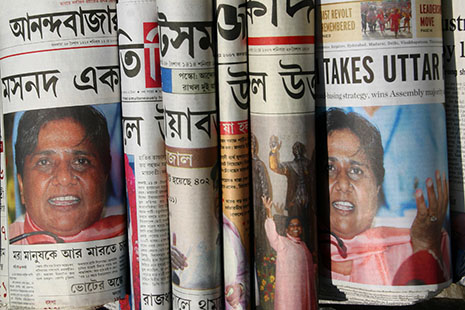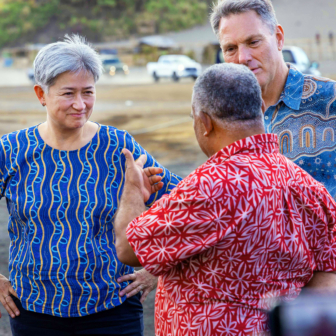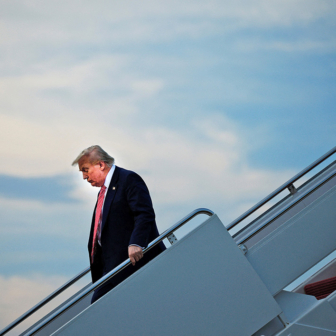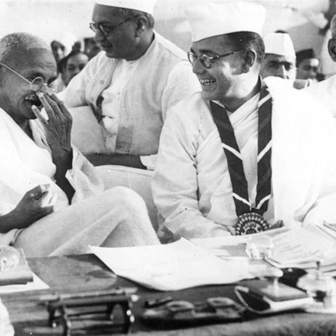IN THE LATE 1960s a small girl set out with her family from a Delhi shantytown to visit her grandparents in one of the many thousands of villages dotted across India. It was a long journey and her parents began to chat with their fellow passengers on the bus. All was well until someone asked where they would be staying in the village. When her parents revealed that their destination was the Chamar Mohalla – the area usually found on the outskirts of a village populated by people on the lowest rung of the caste hierarchy – the other passengers stopped speaking and the girl recalls them physically shrinking away from her family. Her mother explained to her that the caste to which her family belonged was considered by other Indians to be low and unclean. Her response, she said later, was to “hate the caste system with all my might.”
More than forty years later this little girl, known simply as Mayawati, has become the unchallenged hero of lower castes across much of north India. Increasingly, she is also gathering support among other oppressed (and not so oppressed) groups across India. Forbes magazine last year named her as one of the world’s one hundred most powerful women – more powerful than the head of the World Health Organization and the vice chancellor of Harvard University and only marginally less powerful than the chief executive of Yahoo.
In May 2007 Mayawati became chief minister of India’s largest state, Uttar Pradesh, for the fourth time. With Uttar Pradesh’s population numbering around 170 million people, this makes Mayawati responsible for more people’s lives than the leaders of Pakistan, Bangladesh, Russia or Japan. On taking the oath of office she declared that “nobody can stop me from becoming prime minister.”
If you haven’t heard of the fifty-three year old, it’s no surprise. State politics in India rarely makes news and so far Mayawati’s direct influence has been limited to Uttar Pradesh. But after her outstanding win in 2007 and with her party steadily gaining seats in other states, her ultimate goal is no impossibility. If she does become prime minister, she will be unlike any other Indian leader we have seen.
Few doubt her resolve and political ability. During April and May of this year, when millions of Indians get the chance to vote in the next general election, we’ll find out if a majority of Indians agree. If she fulfils her dream, some are even suggesting that she should be seen as India’s counterpart to Barack Obama, a representative of a historically oppressed segment of society reaching the pinnacle of political power. That’s not because she’s a woman – South Asia’s female leaders include the steely Indira Gandhi, who first became prime minister of India in the 1960s, and the recently elected prime minister of Bangladesh, Sheikh Hasina – but because she is a Dalit, the caste historically known as “untouchables” and referred to under the Indian Constitution as Scheduled Castes. How she became so politically powerful in a society which, despite what many urban middle class Indians may like to think, is still riddled with caste discrimination, is a compelling story.
The Dalits in Uttar Pradesh love her, coming in their thousands from far flung villages to hear their Behenji speak at political rallies. She tells them that she is proud to have been born into a Dalit family. “I am the daughter of a Chamar [a Dalit]. I am a Chamar. I am yours.” Caste continues to be the primary reason for their experience of discrimination, oppression, violence, poverty and general exclusion from wider society. Hearing Mayawati take pride in her caste and refuse to accept its traditionally negative value is an empowering experience for those who attend these rallies. In Uttar Pradesh in particular, Dalits claim that her leadership and political success has provided them with dignity and the courage to speak up against their oppressors.
In the big cities of Delhi and Mumbai, meanwhile, the urban middle classes feel alienated from her culture and idiom and fear her influence. Mayawati as a chief minister is one thing but an India with her as prime minister points to a disturbing new world in which they may not find a place. As a Hindi speaking Dalit, she shares neither their culture not their language. One blogger notes the reaction of a young middle class Indian: “If Mayawati becomes PM, won’t that lower India's prestige? She is corrupt, crude and unprincipled. Doesn’t India need a prime minister who is more presentable to the world?” The sense of disconnection between Mayawati’s politics and the lives and concerns of India’s well-off middle classes is palpable.
MAYAWATI WAS BORN on 15 January 1956, the second of nine children from a family who originally hailed from the village of Badalpur in Uttar Pradesh. Unlike most of India’s Dalits, she grew up in the city, in the lower middle class Delhi suburb, Inderpuri, after her father was transferred there by the posts and telegraphs department. Her father, a low level clerk, had access to a regular, if modest, salary, but with nine children the family’s living space was cramped and life was difficult financially.
But Mayawati’s family was able to send her to a government school and understood the importance of education as a means to a better life. Her father encouraged her to study to become a district collector, a government post which would give her both financial security and a significant amount of power. The family wasn’t overly political but – like a lot of Dalit families – each year they would attend festivals celebrating the life of Ambedkar, a Dalit who had become a government minister and who wrote extensively about the condition of the lower castes and how the oppression could be overcome. This early access to a radically different way of thinking about society coupled with her own life experience had an enormous influence on the young Mayawati.
Although she doesn’t appear to have been a brilliant student, Mayawati was a hard worker. She went on to university and gained a bachelor of arts and a teaching qualification. While working in Delhi as a teacher and studying for a law degree she became interested in Dalit politics; she was first noticed by the founder of the Bahujan Samaj Party, Kanshi Ram, when she spoke out passionately at a public meeting against an upper caste politician who referred to Dalits as “Harijan,” a term coined by Mahatma Gandhi that is considered patronising by Dalits. She condemned Gandhi, got people to chant slogans and brought Dalits in the hall to their feet. Ram, who had been involved in mobilising Dalits since the late 1970s, quickly recognised that Mayawati displayed the raw passion and oratory skills required to stir the masses. From that time until his death a few years ago, they were a team with a focused vision for the future of Dalit politics.
The driving force behind Mayawati’s passionate brand of politics is her desire to end caste discrimination and usher in a society that pays more than lip service to the ideals of equality and fairness. Officially, the practice of untouchability and caste discrimination was outlawed in the Indian Constitution in 1950. Unofficially, this did nothing to change the daily lives of millions of Dalits across the country, even after the Prevention of Atrocities Act was introduced to enforce the constitution and bring perpetrators of caste violence to justice.
Discovering the role caste plays in contemporary India is not straightforward. Some urban educated Indians argue that caste hasn’t existed as a social institution since independence and so it no longer has any bearing on people’s lives. But a closer look at the lives of Dalits, and in particular those who live in the rural areas (along with about 75 per cent of the population), reveals a disturbingly different story. Caste does matter. Sometimes it merely operates in ways that cause annoyance – a social slight from someone in a higher caste family, or an upper caste parent discouraging their children from playing with Dalit children. At other times caste has a profound impact on physical, emotional and economic wellbeing.
A recent Action Aid study of more than 500 villages across eleven states illustrates the ongoing problems faced by Dalits and underlines the vast gulf that exists between their lives and those of the urban-based elite. Surveying the prevalence of behaviour that amounts to the practice of untouchability, the study found significant discrimination in the provision of public services including the denial of barber services (in almost half of surveyed villages), separate seating in restaurants (a third of villages), and separate utensils in restaurants (a third of villages). In terms of restrictions on public behaviour faced by Dalits, many villages ban them from having marriage processions on roads (nearly half), from waring new or bright clothes (almost one-in-five). In a quarter of the villages, Dalits were forced to stand rather than sit when in the presence of higher caste men. It takes only a little imagination to consider the psychological impact of being part of a group forced to use separate cups and forks in your local restaurant so that you don’t “pollute” other customers.
Of even greater concern is the fact that physical violence against Dalits is not a thing of the past. The National Crime Records Bureau reports that each day two Dalits are killed and three Dalit women are raped; a Dalit is assaulted every eighteen minutes. Newspaper reports and activist web sites are awash with examples of violence and discrimination occurring across the country – primarily in rural areas.
In October 2007 in a Madhya Pradesh village, a Dalit woman refused to work alone to harvest a crop for a local farmer. The upper caste farm owners tied her to a tree and beat her up, fracturing her limbs. In a final gesture to ensure the maximum possible humiliation, when she regained consciousness and asked for water, the perpetrators instead gave her urine to drink.
Violence is not limited to adult Dalits. There have been numerous documented accounts of children and babies being killed – sometimes in isolated incidents and other times as the result of organised, violent attacks on entire communities and families. Just last week a three month old baby girl was killed because her twenty-five year old mother refused to wash her feet and hands before drawing water from the local well – a centuries-old custom imposed on Dalits only. She was told that Dalits were dirty and not permitted to draw water without first washing. When she refused and attempted to seek help from the local police, she was attacked by seven men who snatched the baby from her mother’s arms, throwing her to the ground and killing her.
Under existing Indian law everything from segregated seating in a restaurant to assaults and murder is illegal. The problem lies not with the law but with the state’s ability and will to implement the law. The BSP points out that Dalits, with neither political nor economic clout, find it hard to get local police to register complaints against influential landowners or those with money and power. Sometimes the police will be bribed into non-action. At other times, they fail to protect the victims from further harassment by the accused who roam free pending trial. Until the BSP came to power, very few police officers were Dalits. The BSP’s ability to gain democratic control over the state’s institutions of power (such as the police force and judiciary) has been a vital part of ensuring the safety of Dalits in Uttar Pradesh and their increased liberation from the threat of violence and intimidation.
Above: Mayawati addresses a press conference in Lucknow, Uttar Pradesh on 11 May 2007 after her party’s victory in the Uttar Pradesh elections
Photo: EPA/STR
THE BAHUJAN SAMAJ PARTY, or BSP, entered the Uttar Pradesh political arena in 1984 with the goal of fighting for the rights of oppressed segments of Indian society. While mainly focusing on Dalits, the party’s rhetoric always included non-Dalit groups such as Muslims and other oppressed castes. At the time, the party was keenly aware that winning electoral power required Dalits to adopt a more confident approach. Mayawati knew that she needed to raise their self-esteem and undo generations of submissive behaviour. The party launched into Uttar Pradesh politics with radical slogans that the upper castes found shocking. Using symbols, language and idioms which were familiar to her audience, Mayawati spoke at length at rallies; with her fire and passion she motivated people to cast votes for the party rather than supporting whoever the local landlord told them to vote for. She built statues of Dalit heroes (including herself and Kanshi Ram) in towns and villages around the state, asserting the right of Dalit identity to be celebrated in the public sphere. A well trained and committed BSP cadre travelled extensively by foot, bicycle and train to spread the message and enlist support.
The strategy represented a major change from the way that Dalits had been wooed in the past. There is little doubt that much of post independence electoral politics saw Dalit votes providing an important element in the electoral fortunes of the Congress Party. But the appeals to Dalits rarely used language or cultural symbols that bore any relationship their cultural identity and experiences. Instead, Congress offered Dalits protection from violence as well as access to poverty alleviation programs which depoliticised their cultural experiences.
Upper caste/class journalists have mocked Mayawati’s approach, calling her a crude “casteist” politician and even accusing her of murdering language (the ultimate insult from the cultural elite but not one that she particularly cared about). They accuse her of corruption and point to the wealth she has accumulated while in politics. The BSP has never worried about what journalists have to say in the elite newspapers and magazines that their followers are unlikely to read. Mayawati’s approach worked and the growth and success of the party in the state has slowly changed feelings of inferiority and inspired Dalits to stand up for themselves.
In the 1989 Uttar Pradesh Assembly elections the party won a modest thirteen seats. Since then, it has gone from strength to strength, culminating in its majority win in 2007. Mayawati had been chief minister three times between 1995 and 2004, but always in unstable coalitions for short periods. Knowing her time in power was likely to be short lived, she aggressively pursued the transfer and promotion of Dalits and loyal party workers into key government positions so that policies favourable to her followers would be implemented and justice for Dalits in rural areas was more likely. Government workers found to be obstructing her programs or police officers who refused to investigate atrocities or acts of criminality against Dalits were transferred or dismissed. The efficacy of this approach supports Mayawati’s long held belief that the emancipation of oppressed groups requires a one-point plan – win power.
Mayawati’s early success was largely due to her ability to forge a political identity from the cultural and social identities of Dalits and their common experience of oppression. But the numerical strength of Dalits in India (a little more than 15 per cent) was never going to be sufficient to win power outright. No political party in India will ever win by appealing only to a particular caste, or arguably to caste issues alone.
The 2007 state election demonstrated Mayawati’s ability to build cross caste alliances and appeal to a wider section of the electorate on the basis of economic and social issues facing people across the state. As far back at 2002, she shrewdly began to build support for the BSP among Brahmins, who are traditionally at the top of the caste structure. Just as Dalits fear the landholding castes in the middle of the caste system, Brahmins in Uttar Pradesh felt intimidated by this group and disempowered by the ruling Samajwadi Party, which had run a nepotistic and relatively lawless government. Her appeal to Brahmin fears of middle caste assertion was supported by a series of Brahmin rallies where she showed herself to be just as capable of tapping into upper caste symbols. In villages across Uttar Pradesh the BSP also set up Dalit–Brahmin Brotherhood Committees to work together on social issues and election strategy. Her approach paid off, with the party increasing its share of Brahmin votes in the state election from 6 per cent in 2003 to 17 per cent in 2007.
Mayawati campaigned on a platform of law and order, and on a promise of development for all people in need, irrespective of their caste. Coupled with some careful handing out of party tickets to ensure castes from across the board were well represented, this was enough to win her power.
In a country plagued with such a significant disparity in wealth between the top and the bottom –135 million out of the 188 million households are considered deprived – and with 59 per cent of Dalits in Uttar Pradesh living below the poverty line, it is significant that the BSP fights for the rights of the oppressed via the ballot box. The party does not engage in violence or aim for a violent overthrow of government. It is looking for social transformation and equality through electoral politics. At times this focus has attracted criticism from Dalit activists, but the leadership obviously believes that a violent quest for social change is usually paid for disproportionately by the poor. The supporting evidence comes from across the state border, in Bihar, where the Naxalite insurgency has led to the formation of armed upper caste citizen armies with devastating results for the poor and the vulnerable.
SINCE THE DECLINE of Congress Party dominance, it’s a brave person who tries to predict the outcome of an Indian election. This doesn’t stop Indian psephologists – but they frequently get it wrong, and never more spectacularly than in the last general election when the vast majority of them assumed that the Bharatiya Janata Party, or BJP, with its India Shining campaign and emphasis on the trappings of a middle class existence, was a certainty to win. Few thought to consider the relevance of a successful call-centre industry to a drought-stricken farmer or what a bullish stockmarket might mean to a rag picker.
Neither of the two major parties, Congress and the BJP, is likely to win sufficient votes to form government on their own. Recent state elections have brought success for both parties with the surprise being the significant number of votes going to the BSP.
The most likely result of this year’s national election is a hung parliament, not an unusual outcome for India. Out of a total of 543 seats at the last election, no single party won more than 145, far short of the 272 needed to form government. If Mayawati manages to win around fifty seats she may find herself the leader of the third largest party in the Lok Sabha and both major parties will have to negotiate with her if they hope to form government. Even then they will still need the support of regional parties and the communist parties (who are opposed to the BJP’s communal bent and still angry with Congress over the nuclear deal with the United States).
Although the BSP only won nineteen Lok Sabha seats in the last general election – all from Uttar Pradesh – things have changed significantly since then. In 2004, Mayawati held only 98 seats in the Uttar Pradesh state legislative assembly. She now holds 206. In other state assembly elections last year the BSP won six seats in Rajasthan (compared to only two in 2003), two in Chattisgarh (same as in 2003) and seven in Madhya Pradesh (compared to only two in 2003). Based on these recent results, it’s safe to assume that the BSP will improve significantly on its 2004 Lok Sabha results.
Mayawati is an astute politician and the BSP has shown itself to be extraordinarily well organised. The party had chosen more than 70 per cent of its candidates for the upcoming election by early last year, allowing each candidate a significant amount of time to get to know their constituency and make the right connections. Fifty seats is certainly not out of the question.
MAYAWATI’S TEMPERAMENT is the unpredictable element in this scenario. She cares nought for what other politicians and the elite think of her and doesn’t hesitate to let them know. It isn’t clear whether she will give her support to one of the major parties in order for them to form government. If she does she is likely to extract weighty concessions. One possibility is that she will offer support to either Congress or the BJP in return for the position of deputy prime minister. Working in coalition again with a party she actively dislikes may not unduly worry her. She is the master of compromise politics, having formed alliances with every other major political party in Uttar Pradesh over the past fourteen years and could easily see this as an acceptable step on her climb to the top. She is nothing if not pragmatic.
Of course there is another possibility – a long shot but a possibility nonetheless. In this scenario, the BSP, the left, and various regional parties would come together to form a non-Congress, non-BJP coalition government, with Mayawati as prime minister. This possibility was nearly put to the test in the middle of 2008 when the Congress-led United Progressive Alliance government was forced to contest a trust vote in the Lok Sabha after the left withdrew its support following the signing of the nuclear deal with the United States.
If a third front alliance did come to power, this Dalit ki beti (daughter of a Dalit) will have come a long way from that bus ride to her grandparent’s village, and the hopes and aspirations of millions of Indians will shift irrevocably. •




